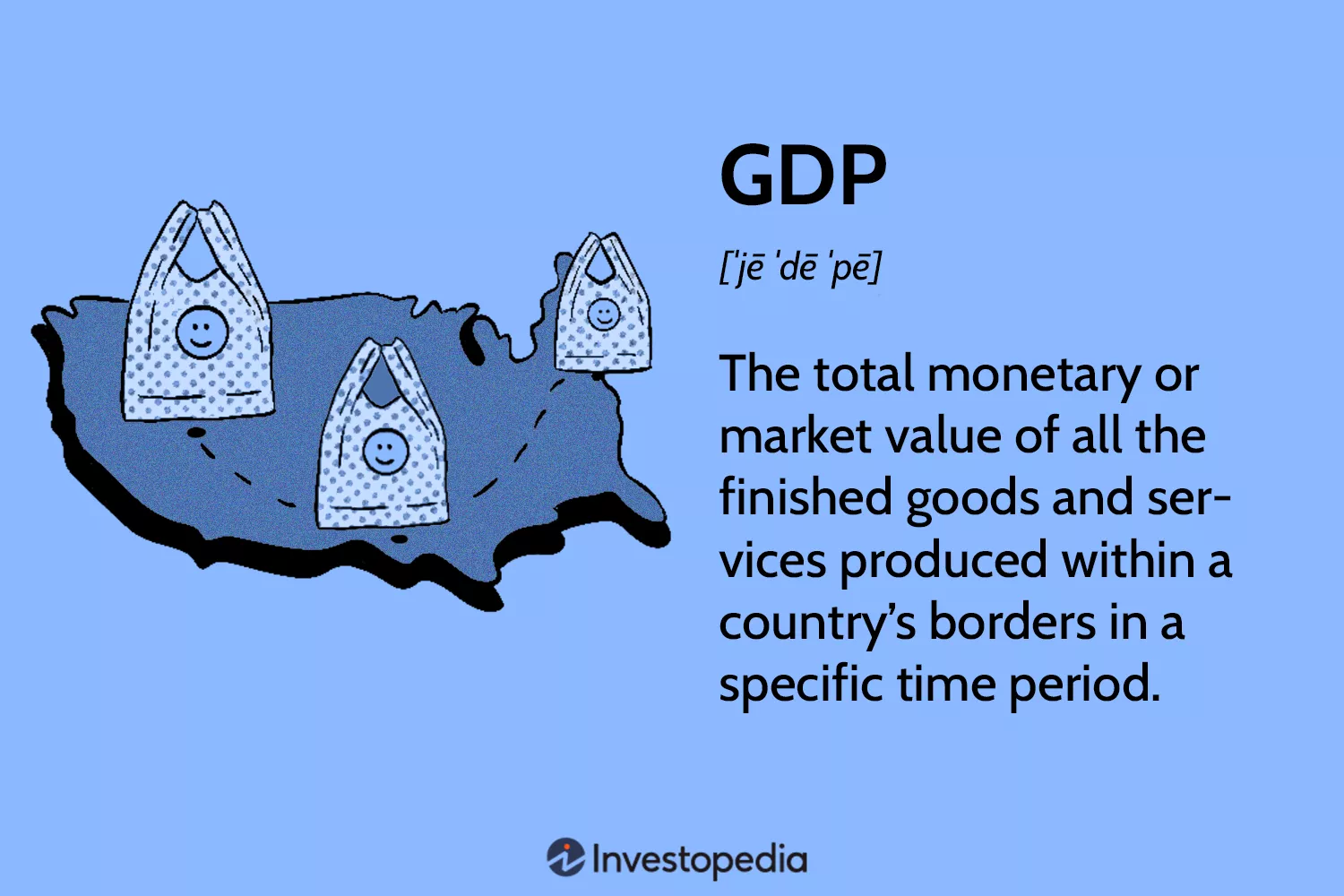Gross Domestic Product (GDP) is a fundamental economic indicator that measures the total value of goods and services produced within a country’s borders over a specific period, typically a year. It serves as a comprehensive measure of a nation’s economic output and is widely used by governments, businesses, and organizations to gauge economic performance, make policy decisions, and assess growth prospects.
The relevance and importance of GDP cannot be overstated. It provides insights into a country’s overall economic health, standard of living, and potential for future growth. By understanding GDP, policymakers can implement strategies to stimulate economic activity, attract investments, and promote sustainable development.
According to the World Bank, the global GDP reached $96.13 trillion in 2021, with the United States, China, and Japan leading as the top three economies. However, the COVID-19 pandemic’s impact on global economic activity led to a contraction of 3.1% in 2020, highlighting the importance of monitoring and analyzing GDP fluctuations.
Table of Contents
- Understanding Gross Domestic Product
- Components of Gross Domestic Product
- Measuring Gross Domestic Product
- Limitations of Gross Domestic Product
- The History of Gross Domestic Product
- Global Gross Domestic Product Trends
- The Future of Gross Domestic Product
- Additional Resources and Further Reading
- Practical Tips and Actionable Advice
- Conclusion
Understanding Gross Domestic Product
Gross Domestic Product (GDP) is a comprehensive measure of a country’s economic output. It represents the total market value of all final goods and services produced within a country’s borders during a specific period, typically a year or a quarter.
GDP is a widely used indicator for several reasons:
- Economic Growth: Changes in GDP over time reflect a country’s economic growth or contraction, providing insights into its overall economic performance.
- Standard of Living: GDP per capita, which is GDP divided by the population, is often used as a measure of a country’s average standard of living.
- Policy Decisions: Governments, central banks, and other policymakers rely on GDP data to make informed decisions regarding fiscal and monetary policies, resource allocation, and development strategies.
- International Comparisons: GDP allows for comparisons of economic output and performance across different countries, enabling global benchmarking and analysis.
Components of Gross Domestic Product
GDP is calculated by summing up four main components:
- Personal Consumption Expenditures: This component represents the total spending by households on goods and services, such as food, clothing, housing, and healthcare.
- Investment: This includes spending on capital goods, such as machinery, equipment, construction, and changes in inventory levels.
- Government Spending: This component encompasses expenditures by government entities at the federal, state, and local levels on goods and services, including public administration, defense, and infrastructure.
- Net Exports: This is the difference between a country’s exports (goods and services sold to other countries) and imports (goods and services purchased from other countries).
The formula for calculating GDP is:
GDP = Personal Consumption Expenditures + Investment + Government Spending + (Exports – Imports)
Measuring Gross Domestic Product
There are two primary methods used to measure GDP:
- Expenditure Approach: This method calculates GDP by summing up the expenditures on final goods and services produced within a country. It is the most commonly used approach and aligns with the GDP components mentioned earlier.
- Income Approach: This method calculates GDP by summing up the income generated by the production of goods and services within a country. It includes wages, salaries, profits, rent, interest, and other forms of income earned in the production process.
In practice, statistical agencies use both approaches to cross-check and reconcile the GDP estimates, ensuring accuracy and consistency.
Limitations of Gross Domestic Product
While GDP is a widely used and valuable economic indicator, it has several limitations:
- Excludes Non-Market Activities: GDP does not account for economic activities that occur outside of the formal market, such as unpaid household work, volunteer work, or illegal activities.
- Quality of Life Considerations: GDP solely focuses on economic output and does not directly measure factors that contribute to quality of life, such as income inequality, environmental quality, or overall well-being.
- Informal Economy: In many developing countries, a significant portion of economic activity takes place in the informal sector, which may not be accurately captured by GDP calculations.
- Sustainability: GDP does not account for the depletion of natural resources or environmental degradation, which can have long-term economic consequences.
Due to these limitations, GDP is often complemented by other economic, social, and environmental indicators to provide a more comprehensive understanding of a country’s overall development and progress.
The History of Gross Domestic Product
The concept of GDP has its origins in the early 20th century, when economists sought to develop a comprehensive measure of a nation’s economic output. The term “Gross Domestic Product” was first coined by the American economist Simon Kuznets in 1934.
However, the roots of GDP can be traced back even further to the work of economists like William Petty, who developed the concept of national income in the 17th century, and Adam Smith, who explored the sources of a nation’s wealth in his seminal work “The Wealth of Nations” in 1776.
The widespread adoption of GDP as a key economic indicator gained momentum during the Great Depression of the 1930s and World War II. Governments and policymakers sought reliable measures to track economic performance and guide policy decisions during these challenging times.</p
In the post-World War II era, the United Nations and other international organizations played a crucial role in standardizing the methodology for calculating GDP and promoting its use as a global economic indicator. The System of National Accounts (SNA), developed by the United Nations, provided a comprehensive framework for measuring GDP and other economic indicators.
Global Gross Domestic Product Trends
Over the past decades, global GDP has experienced significant growth, driven by factors such as technological advancements, globalization, and the rise of emerging economies. However, this growth has been uneven across different regions and countries.
Here are some notable global GDP trends:
- Shifting Economic Power: While developed economies like the United States, Japan, and European countries dominated global GDP in the 20th century, the 21st century has witnessed the rapid rise of emerging economies, particularly China and India. These countries have experienced remarkable economic growth and have significantly contributed to the global GDP.
- Impact of Economic Crises: Major economic crises, such as the 2008 Global Financial Crisis and the COVID-19 pandemic, have had profound impacts on global GDP. These events have led to economic contractions, disruptions in global trade, and changes in consumer behavior, highlighting the interconnected nature of the global economy.
- Role of Technology and Innovation: Technological advancements, particularly in areas like digitalization, automation, and artificial intelligence, have played a significant role in driving economic growth and productivity. Countries and industries that have embraced and invested in these technologies have experienced higher GDP growth.
- Demographic Shifts: Changes in population dynamics, such as aging populations in developed countries and growing workforce in emerging economies, have influenced GDP trends. Countries with favorable demographic profiles and policies supporting workforce participation have experienced economic benefits.
The Future of Gross Domestic Product
As the world continues to evolve, the role and importance of GDP as a measure of economic progress are subject to ongoing discussion and debate. Several factors and trends are shaping the future of GDP:
Sustainability and Well-being Considerations
There is a growing recognition that GDP alone is an incomplete measure of societal progress and well-being. Efforts are underway to incorporate factors such as environmental sustainability, income inequality, and overall quality of life into economic measurements. Initiatives like the Genuine Progress Indicator (GPI) and the Better Life Index (BLI) aim to provide more comprehensive assessments of human and environmental welfare.
Digitalization and the Rise of the Knowledge Economy
The shift towards a knowledge-based and digital economy poses challenges for accurately measuring economic output. Traditional GDP calculations may not fully capture the value created by intangible assets, such as intellectual property, data, and digital services. New methodologies and approaches may be needed to account for the unique characteristics of the modern economy.
Global Cooperation and Standardization
As the world becomes increasingly interconnected, there is a growing need for international cooperation and standardization in measuring and reporting economic data, including GDP. Efforts by organizations like the United Nations, the International Monetary Fund (IMF), and the World Bank aim to promote consistent and comparable GDP methodologies across countries, facilitating global analysis and decision-making.
Addressing Limitations and Complementary Indicators
While GDP will likely remain a cornerstone of economic measurement, there is a recognition of its limitations. Efforts are underway to address these limitations and complement GDP with additional indicators that capture aspects such as environmental impact, social progress, and subjective well-being. This multidimensional approach aims to provide a more comprehensive understanding of a nation’s overall development and progress.
Additional Resources and Further Reading
If you’re interested in learning more about Gross Domestic Product and related economic concepts, here are some additional resources and further reading materials:
- World Bank GDP Data: The World Bank provides comprehensive GDP data and resources, including country-specific GDP figures, growth rates, and analytical tools. https://data.worldbank.org/indicator/NY.GDP.MKTP.CD
- International Monetary Fund (IMF) Publications: The IMF publishes various reports and publications related to GDP and global economic trends, such as the World Economic Outlook and the Global Financial Stability Report. https://www.imf.org/en/Publications
- OECD Better Life Index: The Organisation for Economic Co-operation and Development (OECD) has developed the Better Life Index, which measures well-being across various dimensions, complementing traditional economic indicators like GDP. https://www.oecdbetterlifeindex.org/
- Genuine Progress Indicator (GPI): The GPI is an alternative to GDP that attempts to measure economic progress while accounting for factors such as environmental degradation, income inequality, and other social costs. https://genuineprogress.net/
Frequently Asked Questions
Here are some common questions and answers related to Gross Domestic Product:
Q: What is the difference between GDP and GNP (Gross National Product)?
A: GDP measures the total value of goods and services produced within a country’s borders, regardless of the nationality of the producers. GNP, on the other hand, measures the total value of goods and services produced by a country’s citizens and corporations, including those based abroad.
Q: How does GDP growth relate to employment and standard of living?
A: GDP growth is generally associated with increased employment opportunities and higher incomes, which can contribute to an improved standard of living. However, the distribution of economic gains and other factors, such as income inequality and cost of living, also play a role in determining overall well-being.
Q: Can GDP be negative?
A: Yes, GDP can be negative, indicating an economic contraction or recession. A negative GDP means that the total value of goods and services produced within a country has decreased compared to the previous period.
Practical Tips and Actionable Advice
While Gross Domestic Product is primarily used by policymakers, economists, and businesses, understanding its concepts and implications can be beneficial for individuals as well. Here are some practical tips and actionable advice:
For Individuals
- Stay Informed: Stay up-to-date with GDP reports and economic news, as they can provide insights into the overall economic climate and potential impacts on employment, wages, and cost of living.
- Understand Personal Finance: While GDP measures overall economic output, understanding personal finance principles, such as budgeting, saving, and investing, can help individuals make informed decisions to improve their financial well-being.
- Support Sustainable Practices: Individuals can contribute to sustainable development by making conscious choices in their consumption and lifestyle, supporting businesses and policies that prioritize environmental protection and social responsibility.
For Businesses
- Monitor Economic Indicators: Businesses should closely monitor GDP and other economic indicators to identify trends, assess market conditions, and make informed decisions regarding investment, expansion, or cost-cutting measures.
- Align with Sustainable Goals: Businesses can align their operations and strategies with sustainable development goals, contributing to economic growth while minimizing negative environmental and social impacts.
- Invest in Innovation: Investing in research, development, and innovative technologies can drive productivity, efficiency, and competitiveness, ultimately contributing to overall economic growth and GDP.
For Policymakers
- Utilize GDP Data for Policy Decisions: Policymakers should utilize GDP data, along with other economic indicators, to develop and implement policies that promote economic growth, employment, and overall societal well-being.
- Foster Sustainable and Inclusive Growth: Policies should aim to promote sustainable and inclusive economic growth, addressing issues such as income inequality, environmental protection, and access to opportunities for all segments of society.
- Invest in Human Capital: Investing in education, skills development, and workforce training can enhance productivity, foster innovation, and drive long-term economic growth.
- Promote International Cooperation: Collaborate with international organizations and other countries to promote consistent GDP measurement methodologies, facilitate global trade and investment, and address global challenges that impact economic growth.
Case Study: The Impact of COVID-19 on Global GDP
The COVID-19 pandemic has had a profound impact on global GDP, serving as a real-world example of how external shocks can disrupt economic activity and growth. According to the International Monetary Fund (IMF), global GDP contracted by 3.1% in 2020, marking the worst economic downturn since the Great Depression.
This contraction was primarily driven by the widespread implementation of lockdowns, travel restrictions, and supply chain disruptions, which severely impacted various sectors, including tourism, hospitality, and manufacturing. Governments around the world implemented fiscal stimulus measures and monetary policies to mitigate the economic impact and support businesses and households.
While the global economy has shown signs of recovery in 2021 and 2022, with GDP growth rates rebounding, the pandemic has highlighted the interconnectedness of the global economy and the importance of resilience and preparedness in the face of unexpected crises.
The COVID-19 experience has also accelerated discussions around the limitations of GDP as a sole measure of progress and the need to prioritize factors such as public health, environmental sustainability, and overall societal well-being in economic decision-making.
Conclusion
Gross Domestic Product has stood the test of time as a crucial economic indicator, providing a comprehensive measure of a nation’s economic output and serving as a valuable tool for policymakers, businesses, and organizations alike. However, as the world continues to evolve, the role and limitations of GDP are being re-evaluated, and complementary measures are being explored to capture the multidimensional aspects of societal progress and well-being.
While GDP will likely remain a cornerstone of economic measurement, it is essential to recognize its limitations and embrace a more holistic approach that considers factors such as sustainability, income inequality, and overall quality of life. By doing so, we can strive for a more balanced and inclusive form of economic growth that prioritizes human and environmental welfare.
As we navigate the complexities of the modern global economy, understanding the nuances of GDP and its implications becomes increasingly important for individuals, businesses, and policymakers alike. By staying informed, embracing sustainable practices, and fostering international cooperation, we can collectively work towards a future where economic progress is measured not just by numbers but by its ability to create a better world for all.
In the end, the true value of GDP lies not only in its ability to measure economic output but also in its potential to serve as a catalyst for positive change, guiding us towards a more sustainable, equitable, and prosperous future for generations to come.






